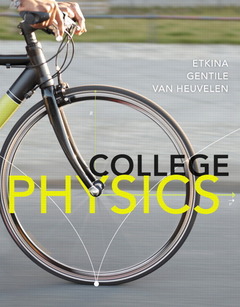Description
College Physics Plus MasteringPhysics with eText -- Access Card Package
Authors: Etkina Eugenia, Gentile Michael, Van Heuvelen Alan
Language: English
Subject for College Physics Plus MasteringPhysics with eText --...:
Approximative price 288.79 €
In Print (Delivery period: 12 days).
Add to cart1200 p. · 10x10 cm · Hardback
Description
/li>Contents
/li>Biography
/li>Comment
/li>
ALERT: Before you purchase, check with your instructor or review your course syllabus to ensure that you select the correct ISBN. Several versions of Pearson's MyLab & Mastering products exist for each title, including customized versions for individual schools, and registrations are not transferable. In addition, you may need a CourseID, provided by your instructor, to register for and use Pearson's MyLab & Mastering products.
Packages
Access codes for Pearson's MyLab & Mastering products may not be included when purchasing or renting from companies other than Pearson; check with the seller before completing your purchase.
Used or rental books
If you rent or purchase a used book with an access code, the access code may have been redeemed previously and you may have to purchase a new access code.
Access codes
Access codes that are purchased from sellers other than Pearson carry a higher risk of being either the wrong ISBN or a previously redeemed code. Check with the seller prior to purchase.
--
College Physics is the first text to use an investigative learning approach to teach introductory physics. This approach encourages you to take an active role in learning physics, to practice scientific skills such as observing, analyzing, and testing, and to build scientific habits of mind. The authors believe students learn physics best by doing physics.
0321822420 / 9780321822420 College Physics Plus MasteringPhysics with eText -- Access Card Package
Package consists of:
0321715357 / 9780321715357 College Physics
032186445X / 9780321864451 Active Learning Guide for College Physics
0321864700 / 9780321864703 MasteringPhysics with Pearson eText -- ValuePack Access Card -- for College Physics
I. Introducing Physics
1. Kinematics: Motion in One Dimension
2. Newtonian Mechanics
3. Applying Newton’s Laws
4. Circular Motion
5. Impulse and Linear Momentum
6. Work and Energy
7. Extended Bodies at Rest
8. Rotational Motion
9. Gases
10. Static Fluids
11. Fluids in Motion
12. First Law of Thermodynamics
13. Second Law of Thermodynamics
14. Electric Charge, Force, and Energy
15. The Electric Field
16. DC Circuits
17. Magnetism
18. Electromagnetic Induction
19. Vibrational Motion
20. Mechanical Waves
21. Reflection and Refraction
22. Mirrors and Lenses
23. Wave Optics
24. Electromagnetic Waves
25. Special Relativity
26. Quantum Optics
27. Atomic Physics
28. Nuclear Physics
29. Particle Physics
Eugenia Etkina has a PhD in Physics Education from Moscow State Pedagogical University and has more than 30 years experience teaching physics. She currently teaches at Rutgers University, where she received the highest teaching award in 2010 and the New Jersey Distinguished Faculty award in 2012. Professor Etkina designed and now coordinates one of the largest programs in physics teacher preparation in the United States, conducts professional development for high school and university physics instructors, and participates in reforms to the undergraduate physics courses. In 1993 she developed a system in which students learn physics using processes that mirror scientific practice. That system serves as the basis for this textbook. Since 2000, Professors Etkina and Van Heuvelen have conducted over 60 workshops for physics instructors and co-authored The Physics Active Learning Guide (a companion edition to College Physics will be available from Pearson in January, 2013). Professor Etkina is a dedicated teacher and an active researcher who has published over 40 peer-refereed articles.
Michael Gentile is an Instructor of Physics at Rutgers University. He has a masters degree in physics from Rutgers University, where he studied under Eugenia Etkina and Alan Van Heuvelen, and has also completed postgraduate work in education, high energy physics, and cosmology. He has been inspiring undergraduates to learn and enjoy physics for more than 15 years. Since 2006 Professor Gentile has taught and coordinated a large-enrollment introductory physics course at Rutgers where the approach used in this book is fully implemented. He also assists in the mentoring of future physics teachers by using his course as a nurturing environment for their first teaching experiences. Since 2007 his physics course for the New Jersey Governor’s School of Engineering and Technology has been highly popular and has brought the wonders of modern physics to more tha
An active learning approach encourages students to construct an understanding of physics concepts and laws in the same ways that physicists acquire knowledge. Students learn physics by doing physics.
- Observational Experiment Tables and Testing Experiment Tables direct students to explore science through active discovery. Students make observations, analyze data, identify patterns, test hypotheses, and predict outcomes.
- Videos, accessed by QR codes in the text or through MasteringPhysics®, accompany nearly every Observational Experiment Table and Testing Experiment Table. Students can observe the exact experiment described in the tables.
- Worked Examples, Conceptual Exercises, Quantitative Exercises, and Problem-Solving Strategies build higher-level scientific skills such as analysis, synthesis, evaluation, and experimental design.
- The Active Learning Guide, which is organized in parallel with the textbook’s chapters, supplements the knowledge-building approach of the textbook with activities that provide opportunities for further observation, testing, sketching, and analysis. The Active Learning Guide can be used in class for individual or group work or assigned as homework.
Students learn to represent physical phenomena in multiple ways using words, figures, and equations, including qualitative diagrams and innovativebar charts that create a foundation for quantitative reasoning and problem solving.
- Qualitative-first system develops conceptual understanding.
- Worked examples use the multiple representations approach to teach students how to solve complex physics problems. Students translate a problem statement into the language of physics, sketch and diagram the problem, represent it mathematically, solve the problem, and evaluate the result.
- Reasoning skills boxes f
These books may interest you

Conceptual Integrated Science 203.90 €


